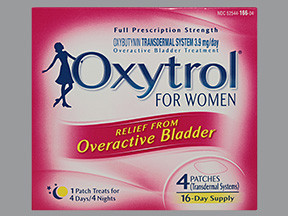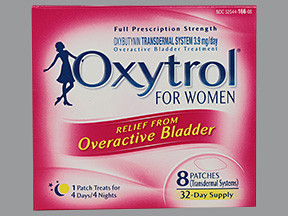OXYBUTYNIN - TRANSDERMAL
PHONETIC PRONUNCIATION: (OX-i-BUE-ti-nin)
COMMON BRAND NAME(S): Oxytrol
GENERIC NAME(S): oxybutynin
Uses
USES: Oxybutynin is used to treat an overactive bladder. By relaxing the muscles in the bladder, oxybutynin improves symptoms such as the inability to control urination (incontinence), feeling that one has to urinate (urgency), and having to go to the bathroom often (frequency). This medication belongs to the class of drugs known as antispasmodics. This medication is not recommended for use in children younger than 5 years of age. Consult your doctor for more information. Unless otherwise directed by your doctor, the over-the-counter product should only be used by adult women who have symptoms of overactive bladder for at least 2 months. For over-the-counter products, carefully read the package instructions to make sure the product is right for you. Check the ingredients on the label even if you have used the product before. The manufacturer may have changed the ingredients. Also, products with similar names may contain different ingredients meant for different purposes. Taking the wrong product could harm you.
How to use OXYBUTYNIN - TRANSDERMAL
HOW TO USE: If you are taking the over-the-counter product to self treat, read all directions on the product package before taking this medication. If your doctor has prescribed this medication, read the Patient Information Leaflet if available from your pharmacist before you start using oxybutynin and each time you get a refill. If your doctor has prescribed this medication, take it as directed. If you have any questions, consult your doctor or pharmacist. Apply one patch to your skin as directed by your doctor, usually every 3 to 4 days. If you are self-treating, apply one patch to your skin every 4 days. Follow the dosing schedule carefully. Remember to remove the old patch before applying a new patch. Apply the new patch to a different area of skin to prevent skin irritation. Do not apply a patch to the same area within 7 days. Before applying the patch, wash the area you will be using for the patch gently and thoroughly with soap and water. Rinse and dry with a clean dry towel. Do not open the sealed pouch container until you are ready to apply the patch. Open the pouch and remove the protective liner from the patch to expose the adhesive. Apply the patch to an area of clean, dry, smooth skin on the stomach (abdomen), hips, or buttocks. Press firmly to be sure the patch stays on. Apply to an area of skin that is under clothing and protected from sunlight. Avoid applying the patch on your waistline, since tight clothing may rub the patch off, or on areas where sitting may loosen it. Do not apply the patch to oily/red/cut/irritated/broken skin or skin covered with lotion or powder. Do not cut the patch into smaller sizes unless otherwise directed. Contact with water (such as swimming, bathing) will not change the way the patch works. Avoid rubbing the patch area during these activities. If the area around the patch becomes red, itchy, or irritated, try a new site. If irritation continues or becomes worse, tell your doctor promptly. If the patch falls off, reapply it or apply a new patch to a new area and continue on your same schedule. When it is time to apply a new patch, remove the old one and dispose of it properly in the trash. Fold the sticky sides of the patch together and throw it away where it cannot be accidentally worn or swallowed by others, especially a child or pet. The length of treatment is determined by your doctor, who may have you stop using the medication sometimes to see if you still need to use it. Use this medication regularly to get the most benefit from it. To help you remember, try to always change the patch on the same 2 days of the week. Do not increase your dose or use this drug more often or for longer than prescribed. Your condition will not improve any faster, and your risk of side effects will increase. Tell your doctor if your condition persists or worsens. If you are self-treating, tell your doctor if your condition does not improve after 2 weeks. If you think you may have a serious medical problem, get medical help right away.
Side Effects
Precautions
Interactions
Overdose
Images

- color
- shape
- rectangle
- imprint
- OXYTROL 3.9 mg/day

- color
- shape
- rectangle
- imprint
- OXYTROL 3.9 mg/day
Reviews
Disclaimer
IMPORTANT: HOW TO USE THIS INFORMATION: This is a summary and does NOT have all possible information about this product. This information does not assure that this product is safe, effective, or appropriate for you. This information is not individual medical advice and does not substitute for the advice of your health care professional. Always ask your health care professional for complete information about this product and your specific health needs.


No Reviews Yet